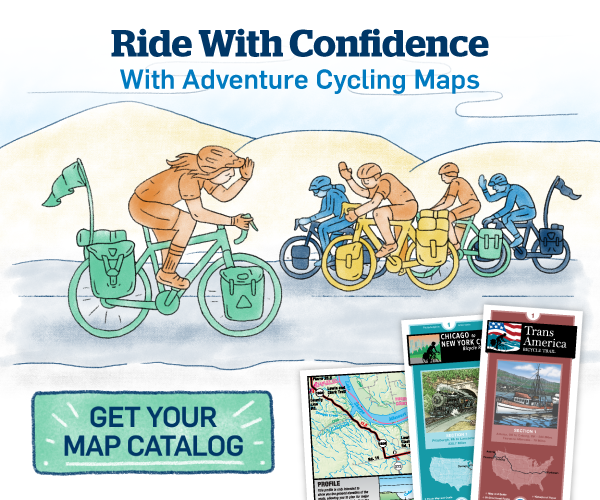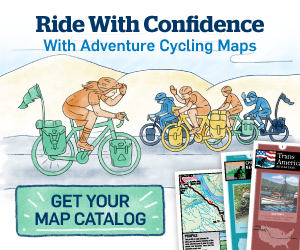Efficient Trip Planning for the Busy Cyclist
Do you ever feel overwhelmed by trip planning? Organizing and executing a bikepacking trip or bike tour is no small feat. There’s gear to gather, food to plan, logistics to sort out, and adverse weather conditions to worry about.
If you often spend the day before your trip running around like a crazy person, trying to remember all the details floating around in your head, chances are you need a better system.
Luckily, with a bit of frontloading, you can use that new system to make all your future trips easier and faster to plan. That means more time to actually enjoy cycling and less time spent staring blankly at the bulk bins in the grocery store. Here are a few tips to make your trip planning more manageable.
Make a Spreadsheet
While the word “spreadsheet” can make some people scream and run away in horror, spreadsheets really don’t have to be scary. At their best, simple spreadsheets can help you organize all the details of your trip in an easy-to-use format.
Start with a general packing checklist that can be tweaked for seasonality and trip specifics. Include both clothing and gear, and a separate section for shared/group gear like tents and camp stoves. Also include a checklist for pre-departure bike tune-ups to ensure that everyone’s bike is safe and ready to hit the trails.
You can also use your spreadsheet to list any logistics related to your trip such as ride-sharing, departure times, securing any permits that are needed, and tasks that need to be delegated. Share your spreadsheet with your trip mates so everyone is on the same page.
Once you have your basic spreadsheet set up, you can reuse it again and again for all types of trips, swapping out trip-specific information but keeping the basics.
Get a Good Map
While blogs, videos, and Google Maps are great resources for trip planning, there’s no substitute for a physical map. A good old fashioned paper map can save you hours and hours of planning time and can certainly come to your rescue in the event that technology fails while out on the trail.
Try to find a map that includes camping spots and water refill stations along your desired route. Highlight your planned itinerary, and be aware of any detours or pit stops you might want to make. Make sure to bring a waterproof case for your map so it doesn’t get damp while you’re outside.
Organize Your Gear
Organizing your cycling gear makes it less likely that you’ll forget something while packing. Of course, by this point, you’ll have your handy packing checklist from your spreadsheet to refer to, so forgetting items won’t be a problem anyway.
Use plastic bins to organize your go-to gear items. Label each bin with its contents to make things extra easy for yourself. That way, you’ll know exactly which bin contains your headlamp and spare batteries, which one has your biking gloves, and which one houses your spare tubes.
When it’s time to pack, you can just go through the bins with your checklist. Of course, this only works if you also unpack in an organized fashion, putting all the gear you used back into their respective bins for easy access before your next trip.
Have a Go-To Food Plan
Food is the thing that often trips me up the most while trip planning. Sometimes it’s just hard to think of what to eat, how much will be needed, and how to pack it all efficiently.
One thing that has helped me significantly is to stock up on dry goods ahead of time. Buy a bunch of things like minute rice, oatmeal packets, ramen, protein bars, trail mix, dried fruit, and other snacks (enough to last for several trips) and put them in a dedicated bin.
Buying in bulk ahead of time means that whenever it’s time to pack for an upcoming trip, you can gather all your dry goods from your stockpile and simply buy any fresh food that’s needed to supplement. It saves a ton of time and brainpower because you basically only have to do the thinking and planning once. Your bin of food may even inspire you to go on trips more spontaneously and often since you don’t want food sitting in a tub forever.
Recycling meal plans is another good way to save time and improve trip planning efficiency. If you had a really amazing meal while on the trail one night, write it down and use it again on your next trip. There’s no need to reinvent the wheel each time (unless you want to).
Final Thoughts
Trip planning doesn’t have to feel hectic or overwhelming. Doing a bit of work upfront can save you a lot of time and energy on future trips. If you make a trip planning spreadsheet, get (and use) a paper map, organize your gear, and utilize a go-to food plan, the details of your next trip will basically organize themselves. The next time someone bemoans the pains of trip planning, you can confidently say, “Don’t worry. I’ll take care of the details!”


Comments
food plan
Thanks Lettie, I enjoyed your article. I was wondering if you could post a pic of your spreadsheet. I'm a list maker, but don't think in spreadsheet so much. I'm very curious as to what yours looks like.
I find that the bike ride is the easy part and the logistics is the challenge. A friend I met on Cycle Montana in 2001 and I have done the Lewis & Clark trail over 4 summers, The Natchez Trace, and Montreal to Quebec. We would find a bike shop in our start point, ship our bikes via UPS ( now bike Flights), fly to the start point, ship the bike box to our destination and head off on our bikes. At the endpoint we would pack up the bikes, ship them home and fly back. We would ride our fully loaded bikes, camping most of the time and it was always a delight. Our only glitch was in Canada- we shipped the bikes and they got hung up in customs. It took a day to get that cleared, but we thought we were stuck again at the finish. all of the UPS stores were closed- July 1- Canada Day, but Air Canada would take our bikes for a $50 charge- less than half of UPS.
As I sat here thinking about the many cycling trips I have finished and planned extensively for the bin idea is great. I have used crates for the bulky items and small boxes (leftover boxes such as from Amazon)for the smaller items. Packing for balance is very important for the panniers rider vs the follow along trailer. First time going down a steep grade at 35+ mph and your bike is wobbling horribly and setting up your heart for a leap out of your throat, loading the bike properly means a great deal to your safety. Great tips and thanks for the information.
Forgot Password?
Enter your email address and we'll send you an email that will allow you to reset it. If you no longer have access to the email address call our memberships department at (800) 755-2453 or email us at memberships@adventurecycling.org.
Not Registered? Create Account Now.